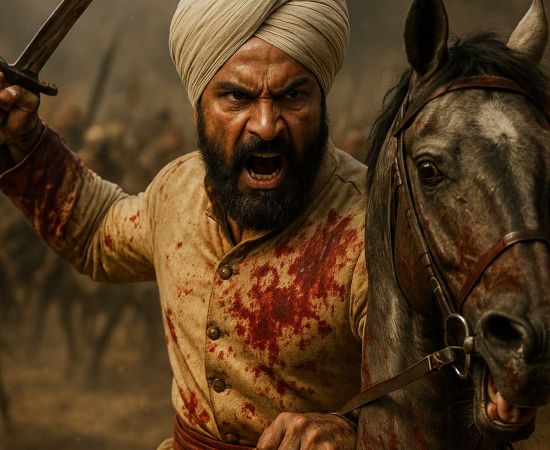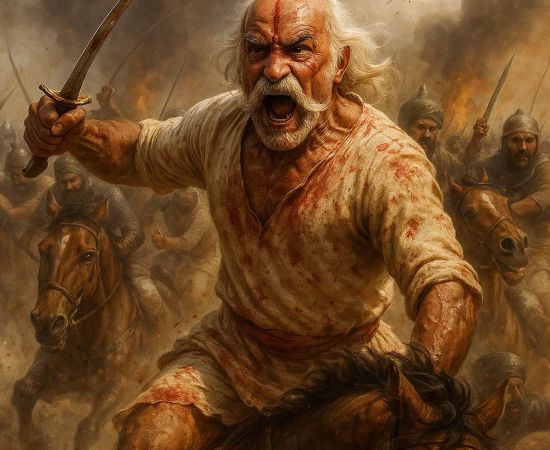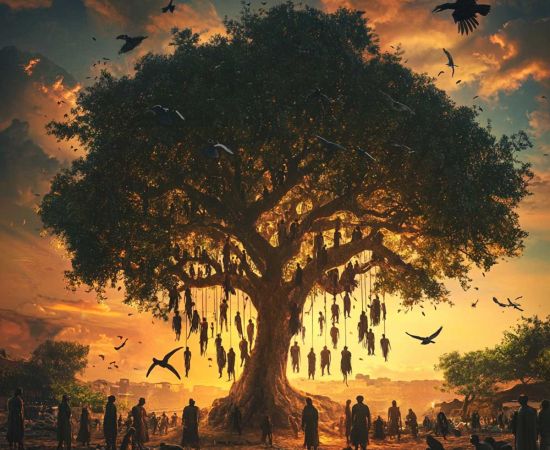MORE COVERAGE
Twitter Coverage
Satyaagrah
Written on
Satyaagrah
Written on
Satyaagrah
Written on
Satyaagrah
Written on
Satyaagrah
Written on
JOIN SATYAAGRAH SOCIAL MEDIA
Bahadur Shah and his jihad in Punjab: 306 years ago, Sikh warrior Baba Banda Singh Bahadur who treaded glorious path of fighting for faith and justice was fed his son’s liver and heart by Mughals before cutting him into pieces
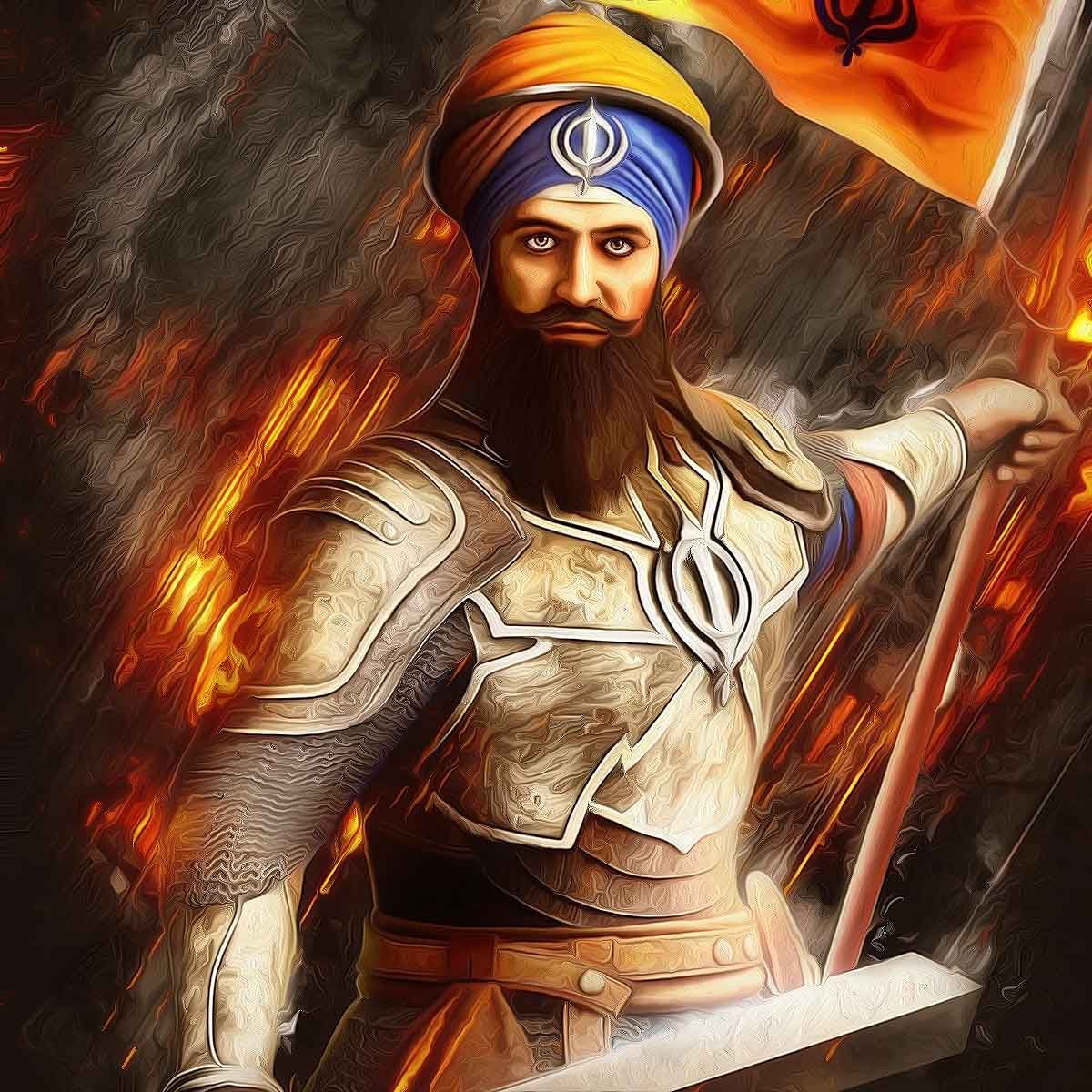
The history of wars in India glorifies several Indian leaders who fought against invading forces s for the rights, faith, and freedom of the persecuted, common individuals. Many warriors, while fighting for the justice and independence of Bharatiyas also met their torment death at the hands of Islamist persecutors.
One such warrior was Baba Banda Singh Bahadur, who fought against Mughal Emperor Bahadur Shah and his ‘jihadi’ activities in Punjab. Celebrated for his velour and commitment to Dharma, Baba Banda Singh Bahadur’s story depicts the unimaginable atrocities done by the Mughals.
Back in the 18th century, Baba Banda Singh Bahadur was that one bright light, who gathered the army of thousands of Sikhs and revolted against the Islamic oppressors. While the state in pursuance of its policies fails to identify and glorify the rich history and heritage of Punjab, here’s the time to remember Baba Banda Singh Bahadur and his times on his 306th death anniversary today.
Over 300 years ago, when Mughals were torturing, establishing their power, and accomplishing crimes against the common people in the old Punjab, Baba Banda Singh Bahadar, the great disciple of Guru Gobind Singh ornamented himself with the arms against the tyranny to defend and safeguard the humanity. He led the campaign against the Mughal empire and pledged to punish Subedar Wazir Khan and his supporters who had killed Guru Gobind Singh’s two younger sons, Sahibzada Zorawar Singh and Sahibzada Fateh Singh along with others.
|
The Sikh warrior was conferred the title of Banda Singh Bahadur by Guru Gobind Singh
Born in Rajouri in Jammu’s Punch, Baba Banda Singh Bahadur was first named Lachhman Dev who possessed a sensitive heart. As a young man, he had shot a doe and was shocked to watch the mother and her aborted fawn in pain and dying. This experience was enough for him to decide to leave his home and reside in solitary. He then became a disciple of Bairagi Sadhu Janaki Das who gave him the name, Madho Das.
Madho Das settled in the Nanded area of Maharashtra after traveling all over Northern India. There, he built a small monastery to meditate upon God. In the year 1708, Guru Gobind Singh, who had travelled to Deccan with the Mughal Emperor Bahadur Shah happened to meet Madho Das. The equation between the duo appeared disturbing as Das made several failed attempts to humiliate the Guru. Das having tried all his powers on Guru Gobind Singh, accepted his defeat and with great humility surrendered to the Guru.
It is Guru Gobind Singh who conferred the title of Banda Singh Bahadur to Madho Das and encouraged him to fight for the righteousness and justice of the common people. He asked him to give away his recluse lifestyle and deputed him to end the Mughal persecution of innocents in Punjab. Further, a Hukumnamah issued by the Guru sought many Sikhs to join Baba Banda Singh Bahadur’s struggle against the Mughals.
Wars against Mughals
Baba Banda Singh Bahadur reached Punjab in 1709 and established his base at Mukhlisgarh. He fought several wars against the Mughals putting Sayyed Jalaluddin, his brothers Sashal Beg and Bashal Beg, the executioner of Guru Teg Bahadar and Sahibzada Zorawar Singh and Sahibzada Fateh Singh respectively to death at Samana. Wazir Khan, the Nawab of Sirhind could not digest Baba Banda Singh Bahadur’s victory at Samana and sent urgent messages for help to Bahadur Shah.
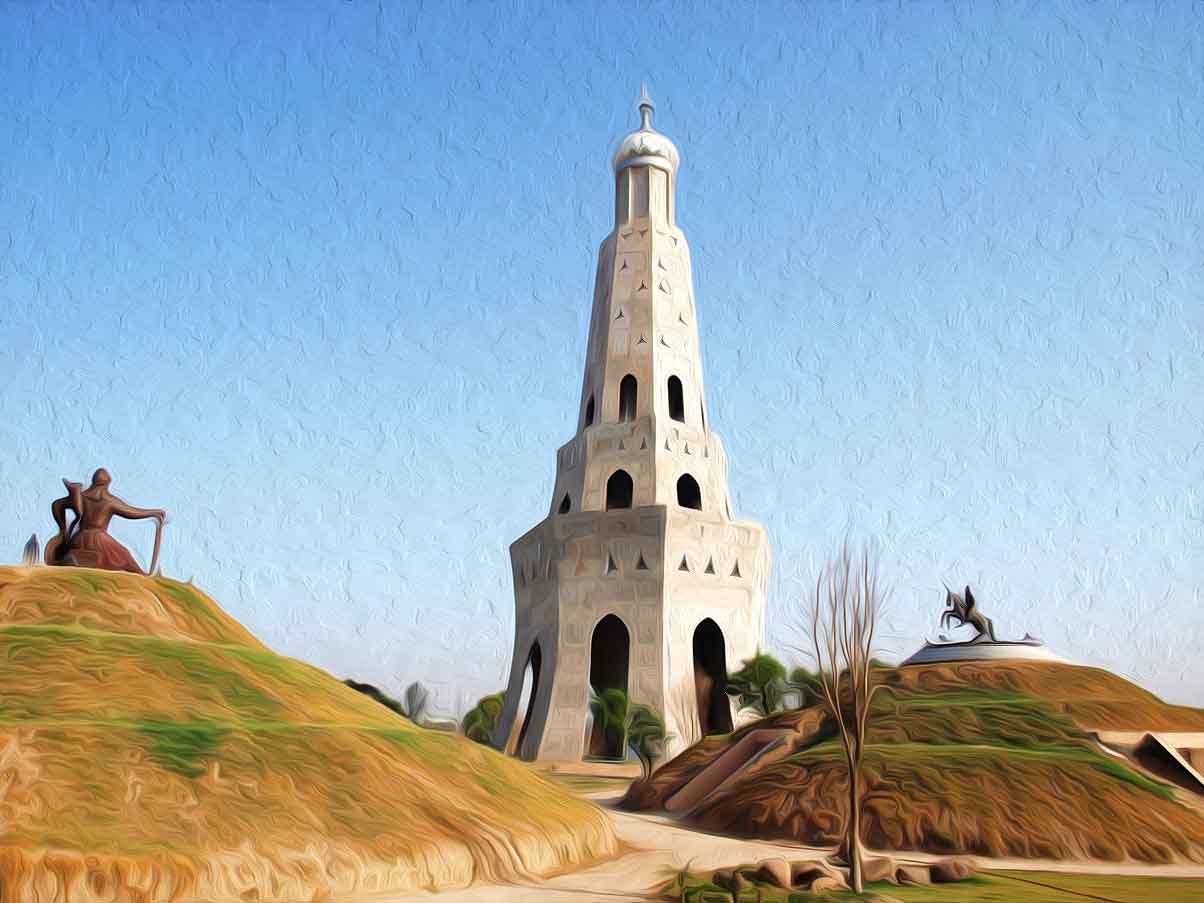 Baba Banda Singh Bahadur War Memorial, Mohali |
At Chapper Chiri, in 1710, Baba Banda Singh Bahadur later put Wazir Khan to death as he had ordered the killing of two younger sons of the Guru after their refusal to accept Islam. He continued to fight against the Mughals even after Guru Gobind Singh’s death and defeated the rulers of Saharanpur, Nanauta, Jalalabad, the Ram Rayias of Ghudani, and Faujdars of Batala, Sonepat, and Sultanpur.
Mughals gave open call to ‘Jihad’
As Khalsa established rule over Punjab and also occupied the Pathankot area, Lahore, the then capital of Punjab was threatened by Mughals who gave an open call for ‘Jihad’ against Banda’s army. Enraged by the sequence of events, Emperor Bahadur Shah posed himself a challenge to attack and defeat Baba Banda Singh Bahadur and his army. He moved northwards from Delhi in June 1710 and poisoned some of the prominent men from Baba Banda Singh Bahadur’s army. Bahadur Shah also issued a general warrant for his soldiers to kill the Sikhs, wherever they were found.
Baba Banda Singh Bahadur moved into the hills of Nahan and re-emerged at Kiratpur Sikhs. After Bahadur Shah’s death in the year 1712, Jahandar Shah became the emperor, and then in 1713 Farukhsiyar became the Emperor, who continued the war against Baba Banda Singh Bahadur. In the year 1713, Farukhsiyar directed the Governor of Lahore Abdul Samad Khan and his son Zakariya Khan to kill Baba Banda Singh Bahadur and eliminate his troops in entirety. Though Baba Banda Singh Bahadur and his army adopted fierce tactics to strike back, the army of Baba Banda Singh Bahadur could not match the massive Mughal attack.
Baba Banda Singh Bahadur and his army entered the Haveli in Gurdaspur Nangal. They were surrounded by the Mughals who defeated them and tortured them badly. Later in December 1715, they were dragged to Lahore and from there were taken to Delhi. Around 720 the Sikhs were asked to convert to Islam and were executed in a most inhumanly manner after they refused to renounce their religion.
Baba Banda Singh Bahadur made to eat his son’s flesh before death
Baba Banda Singh Bahadar and some 20 of his prominent soldiers were also put to untold mental and physical torture. The 20 soldiers were tortured to the extreme and were asked to convert to Islam. They were also asked to reveal the place where they had buried all the treasures they had during their better days. Failing to attain any such information, Mughals carried out a special procession on June 9, 1716. Baba Banda Singh Bahadar was made to dress in the mock attire of the emperor and was made to sit on the elephant, while his 20 odd soldiers were made to march behind him on the streets of Delhi. The procession headed to the Kutub-ud-din mausoleum of Bahadur Shah, near the present Kutab Minar.
The Sikhs, before their death, were again given the option to choose from between conversion to Islam or death. They all were later beheaded as they refused to convert to Islam. The Mughal army then arranged the heads of 20 Sikh soldiers in a circle around Baba Banda Singh Bahadur. They placed his 4-year-old son named Ajai Singh on his lap and ordered Baba Banda Singh Bahadur to kill him with a short sword. As Baba Banda Singh Bahadur stayed unmoved, one of them moved towards Ajai Singh and cut him into two. They removed flesh from inside the body of Ajai Singh and threw it on the face of Banda Singh. They also plucked flesh pieces of the deceased and stuffed the unfortunate father’s mouth with his son’s liver and heart.
Further, the Mughals barbarically tortured rock-faced Banda Singh and put him to death. They removed his eyeballs first, then slashed his legs and separated both his arms from his body. Later they tore off his flesh with red-hot pincers and felt satisfied only after cutting his body up into a hundred pieces.
Banda Singh’s regime, though short-lived, had a far-reaching impact on the history of the Punjab. He treaded the glorious path of fighting for faith, justice and rights and motivated warriors like Baba Deep Singh, Chhajja Singh, Bhuma Singh, Hari Singh Dhillon, Jassa Singh Ramgarhia, Jassa Singh Ahluwalia, Budh Singh, Naudh Singh and Charhat Singh Sukerchakia and many others to keep aloft the ‘flame of liberty’ burning bright.
References:
opindia.com
 Support Us
Support Us
Satyagraha was born from the heart of our land, with an undying aim to unveil the true essence of Bharat. It seeks to illuminate the hidden tales of our valiant freedom fighters and the rich chronicles that haven't yet sung their complete melody in the mainstream.
While platforms like NDTV and 'The Wire' effortlessly garner funds under the banner of safeguarding democracy, we at Satyagraha walk a different path. Our strength and resonance come from you. In this journey to weave a stronger Bharat, every little contribution amplifies our voice. Let's come together, contribute as you can, and champion the true spirit of our nation.
 |  |  |
| ICICI Bank of Satyaagrah | Razorpay Bank of Satyaagrah | PayPal Bank of Satyaagrah - For International Payments |
If all above doesn't work, then try the LINK below:
Please share the article on other platforms
DISCLAIMER: The author is solely responsible for the views expressed in this article. The author carries the responsibility for citing and/or licensing of images utilized within the text. The website also frequently uses non-commercial images for representational purposes only in line with the article. We are not responsible for the authenticity of such images. If some images have a copyright issue, we request the person/entity to contact us at This email address is being protected from spambots. You need JavaScript enabled to view it. and we will take the necessary actions to resolve the issue.
Related Articles
- 26th December to be observed as Veer Baal Diwas to pay gratitude to martyr sons of Guru Gobind Singh: PM Modi
- Genghis Khan's decision to not invade Bharat (land of fabulous wealth) has perplexed historians for centuries: Mystery revealed
- Congress-Left corporal commination, BJP’s moment of convenience: Mainstreaming the ‘Nationalist Muslim’ with the reinstallation of Hindutva
- Advocate Rastogi noted that required evidence could be procured only through an ASI survey, ‘Land belongs to Lord Vishveshwar, Aurangzeb had no right over it’: Argument in Allahabad HC in Kashi Vishwanath-Gyanvapi dispute
- Islamic revivalist movements in Bharat and Deoband’s link to Taliban
- How Africa’s traditional religions were exterminated by Islam and Christianity
- Hero of Pawankhind: Veer Maratha Bajiprabhu Deshpande, who led 300 Soldiers against 12000 Adilshahi Army defending Shivaji
- 'Baba mil gaye', Nandi faced Shivling found inside the well and is 12 feet by 8 inches in diameter: Disputed Gyanvapi structure sealed, CRPF deployed and Court prevent Muslims from entering the complex
- NMA received outrage from Netizens for asking ASI to remove Ganesh idols from Qutub Minar complex to National Museum as it will remove the big evidence of Islamist vandalism: Ganesha is the prime god of Hinduism
- Status of women in the Muslim world - Army Chief of Bijapur Sultanate Afzal Khan and the tragic story of his 63 wives whom he murdered
- How Chhatrapati Shivaji Maharaj was establishing Hindu Samrajya by concluding centuries of Islamic oppression - Historian GB Mehandale destroys secular propaganda against Hindu Samrajya Divas
- ‘Liberal’ elites has issue with Hindu identity of PM Modi and emphasize "Aakhir Albert Pinto Ko Darr Kyun Lagta Hai" – Deciphering the latest rants of Naseeruddin Shah
- Chronicles of Valour- The Battle of Haldighati
- Defying Court order, Gyanvapi Mosque management committee refuses to allow videography inside the mosque and calls it unethical: Petitioner had sought permission for worshipping Gods on the outer wall of Mosque
- Dangers of losing our identity: Guru Tegh Bahadur forgotten and Aurangzeb being glorified




















